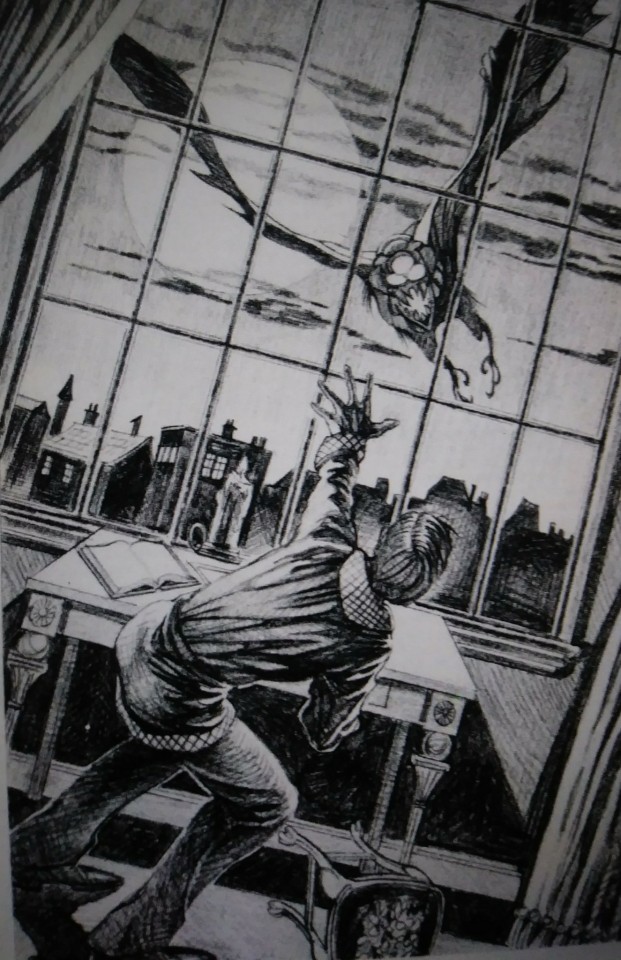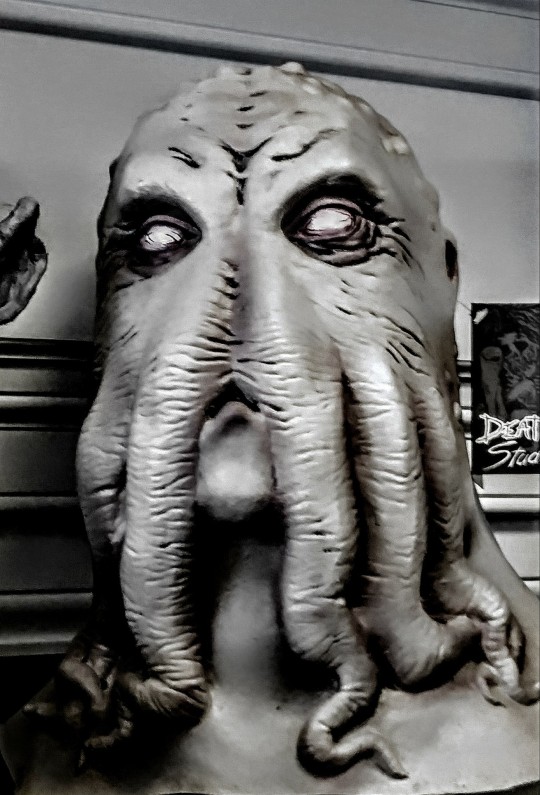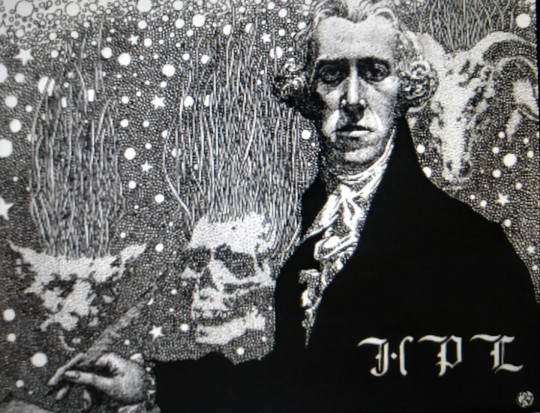#shared elements by other writers in HPL's fiction
Explore tagged Tumblr posts
Text
There is some curiosity about the fact that Lovecraft mentioned characters, books, cosmic entities, or legendary places created by other authors. Is he saying by doing so that because Frank Belknap Long's, ' The Hounds of Tindalos", various books or characters invented by Robert E. Howard, the "Aklo Language' featured in the works of Arthur Machen, 'The King in Yellow' character created by Robert W. Chambers, etc, etc, are mentioned briefly in his own fiction that these fictional creations by others should now be considered legitimately linked with his own en masse. In my humble opinion the answer is, 'NO'. What HPL did by repeating these myriad subjects was only to give the impression that the ultimate over-arching inspiration for these inventions was a higher, and ultimately ulta-cosmic origin. Even in Lovecraft's time there were individuals who insisted that HPL and some of his writer pals were "channelling" the thoughts of higher supernatural powers. Lovecraft of course thought these persons were deluded and pathetic. In some cases he even expressed sympathy for their childish ignorance. So, can we really expect to gain any definite understanding of Lovecraft's developing mythology from reading the works of Clark Ashton Smith, Arthur Machen, Edgar Allan Poe, or any other horror writer Lovecraft mentioned in passing? Absolutely not! These references were window trimming only. I'd be happy to consider any opinions otherwise. (Exhibit 426)




9 notes
·
View notes
Text
It has been said by several critics that H. P. Lovecraft could not write dialogue. Certainly the type of dialogue that we see commonly in various and sundry novels by popular writers is missing or considerably truncated in Lovecraft's stories. There is, however, a very good reason for that. The majority of HPL's tales are narratives told by a single person. Entering the mind of that narrator is almost always key to the whole telling of the tale. We are told not so much what our hero - or perhaps more rightly 'victim' - says but rather how he 'feels' as the tale progresses. We 'become' the narrator, seeing what he sees from his lone perspective (Lovecraft's narrators are never female, but they are very rarely common salt of the earth males either). Our new 'self' is exposed to wondrous and eventually horrible conditions and "TRUTHS" the likes of which we ourselves have never previously experienced. Because of this alienation from 'normal' reality our loneliness and dislocation from others of our species deepens. Conversation between two or more individuals cannot describe in depth the emotion and evaluations of our respective fictional hero in full. Certainly there are brief examples of dialogue in Lovecraft's stories but even these usually amount more to "speeches" than conversations. The story told by the town drunk, Zadok Allen in THE SHADOW OVER INSMOUTH is a perfect example. I liken that speech almost to the famed narrative of Capt. Quint below decks in the movie JAWS. Again, Lovecraft's stories were mostly short. Dialogue in short tales of horror generally becomes confusing and brakes the tension and flow of 'atmosphere'. For Lovecraft, atmosphere was the absolute key element in any tale or horror. Dialogue has its place in novels perhaps, but HPL wrote only one real novel in his life and that did not see publication until years after his death. Again, when we enter the mind of one of Lovecraft's characters we almost always find ourselves sharing the thoughts, feelings, and perspective, of a person oftentimes more intelligent, sensitive, erudite, and perhaps for a little while closer to losing their sanity than we will ever be. IF WE ARE LUCKY! (Exhibit 478)








3 notes
·
View notes
Text
Clark Ashton Smith (Jan. 13, 1893 - August 14, 1961) corresponded by letter with H. P. Lovecraft from 1922 until Lovecraft's death in 1937. In the letters which passed between the pair (they never met in person) there is a remarkable similarity in style and literary form. Certainly in Lovecraft's letters to Smith there was a tendency to reference fanciful ideas and a further development of his own fictional mythic backstory. Lovecraft never dared to lecture Smith, who was very close to his own age, on literary subjects. HPL took the attitude of 'teacher' and father figure to some of his younger correspondent friends like Long, Derleth, and Conover. Considering the sympatico elements of their fictional styles it is perhaps surprising that Smith and Lovecraft never created any tales together. Smith, however, was much more varied in his fictional creations than HPL. Many of Smith's stories were "interplanetary" whilst Lovecraft's nearly always centered on earthly events. Certainly there were alien beings from other planets or dimensions in Lovecraft's fiction, but in every case they had colonized our planet from other origins and the 'action' was always centered on Terra Firma. Lovecraft and Smith may have been hesitant to create a story together because the possibility of creating a row over any disagreement over particulars was always a potential. Most of the collaborations created by Lovecraft and others had been with the master essentially helping out younger writers. E. Hoffmann Price though close in age to HPL shared credit with Lovecraft in writing, THROUGH THE GATES OF THE SILVER KEY, but Lovecraft changed all but 50 words of Hoffmann's drafts and was never happy with the result even then. Collaboration was always a potential for stiffness and restriction for Lovecraft. Though it seemed that HPL respected Smith tremendously as an artist there were certainly glaring differences in the two men otherwise: Smith often explored erotic subjects in his tales and poetry, Lovecraft avoided discussions on sex whenever possible. In his letters to friends like August Derleth, Smith on the other hand was not hesitant to mention "making love" to his female dates. Smith had no problem enjoying a few glasses of wine either - Lovecraft claimed he had never touched alcohol of any kind in his whole life. Smith wore a moustache for most of his adult life. Lovecraft had a dislike of facial hair of any kind. Clark Ashton Smith had a tendency to wear clothing styles that Lovecraft would never have been seen dead in! Shirts with large lapels, barets, and somewhat ' progressive' jackets would never have been seen on the ultra- conservative Lovecraft. Lovecraft had a certain ability to overlook or forgive disagreeable elements in persons who otherwise showed creativity as poets or artists. Even in his day, artistic types displayed a tendency to be a bit eccentric in dress, speech, morality, or personal values. Lovecraft may have objected to certain persons in the abstract, but those who knew him personally nearly all claimed that he was a very loyal friend. (Exhibit 336)


12 notes
·
View notes
Text
A drawing of Tsathoggua as discribed by H. P. Lovecraft in several of his ghost written 'revisions'. Lovecraft lifted Tsathoggua from his Weird Tales writing buddy Clark Ashton Smith. HPL's version of the 'furry toad idol' was somewhat different than Smith's. Lovecraft made occasional reference to characters and fanciful elements in other writer's fiction. He lifted the 'Aklo Writing' from Arthur Machen and made vauge allusions to names found in Chambers, King in Yellow stories. CAS commented to A. Derleth that he was somewhat surprised to see his Tsathoggua character show up in a 'revision' penned by a client of Lovecraft's - this was before Smith's monster-entity even saw print under Smith's name! Smith seemed somewhat confused at this, wondering if he had ever given HPL 'permission' for such! Of course all communication between Smith, Derleth, and Lovecraft, was by letter only - none of them ever met in person. Anyway, Lovecraft's casual attitude about sharing elements of his fiction probably signaled a green light for August Derleth to take the whole thing to an extreme. Many of Derleth's manipulations of Lovecraft's concepts after Lovecraft passed carried the mythology of Lovecraft to regions far outside HPL'S origional ideas. Drawing from the late 1970s by Richard G. Huber. (Exhibit270)

12 notes
·
View notes